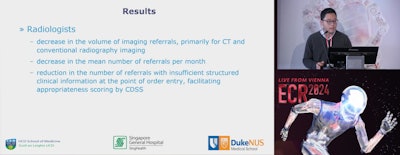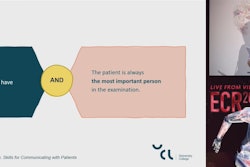Implementing imaging referral guidelines not only supports value-based radiology but makes it easier to communicate with patients about low-value services, according to findings presented February 29 at ECR 2024.
In an open forum, Yi Xiang Tay, of Singapore General Hospital's radiography department, shared his team's research. It was the endnote of a series of sessions focused on optimizing radiology services.
"Low-value imaging procedures result in an ineffective allocation of resources and imposes potential danger," Tay said. "This includes increasing patient costs, the rise of cancer, and increasing detection of incidental findings that often require further investigation and even potentially surgical proceedings of questionable benefit. All this goes against the objective of value-based healthcare."
Tay said while radiology professional societies have advocated incorporating evidence-based imaging referral guidelines into clinical practice, the extent of progress in implementing these guidelines varies worldwide.
 In an open forum for radiographers at ECR 2024, Yi Xiang Tay, of Singapore General Hospital's radiography department, shared his team's systematic review of the impact of imaging referral guidelines on patients and radiology services.
In an open forum for radiographers at ECR 2024, Yi Xiang Tay, of Singapore General Hospital's radiography department, shared his team's systematic review of the impact of imaging referral guidelines on patients and radiology services.
To raise awareness of the benefits and impact, Tay and colleagues reviewed the associated outcomes of imaging referral guidelines for key stakeholders that included patients and radiologists.
"While there are recent scoping reviews that examine the use of imaging referral guidelines to establish and evaluate the appropriateness or value of diagnostic imaging, the true impact of imaging referral guidelines on both patients and radiology services remains unclear," Tay explained.
After a critical appraisal of hundreds of citations published between 2013 and March 2023, the researchers gleaned 31 studies for their narrative review. They found the most common imaging referral guidelines were from the American College of Radiology (ACR), followed by the European Society of Radiology's (ESR) iGuide, and the Royal College of Radiology's (RCR) iRefer. In addition, clinical decision support systems were the most evaluated mode of intervention, either integrated or standalone.
In his presentation, Tay said the combination reduced radiation from CTs and x-rays and reduced unnecessary intravenous contrast administration for patients, mitigating side-effects of contrast. Also, referral guidelines contributed to more consistent medical care which translated into patient satisfaction, he said.
For the radiologist, Tay's team's research showed a decrease in the volume of imaging referrals, primarily for CT and x-ray imaging. There was also a reduction in the number of referrals with insufficient structured clinical information at the point of an order entry.
For the health policymakers, there was an increase in high-value imaging, Tay said. There was also a rise in the number of appropriate imaging referrals accompanied by a corresponding downward trend in inappropriate imaging referrals, among other findings.
"Additionally, it also enhanced their dialog with patients about low-value services," Tay said.
Tay's team concluded that their review produced convincing evidence that adoption of imaging referral guidelines in clinical practice can effectively impact healthcare costs, improve healthcare quality and outcomes, and foster value-based radiology.
"From the results of the study, imaging referral guidelines are an essential component of improving the value of radiology in the healthcare system," Tay said in an email. "However, there was a need for broader dissemination of imaging referral guidelines to healthcare providers globally in tandem with harmonization of the application of these guidelines."
For their next project, Tay and colleagues plan to conduct a cross-sectional survey of emergency department physicians on their perspective on making imaging referrals, as well as perform a health technology assessment of a clinical decision support system in the Singapore Emergency Department.
For more coverage from ECR 2024, please visit our RADCast.



















